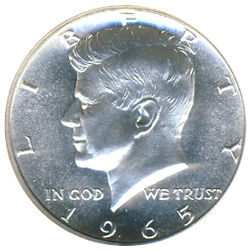

Some of the most renowned coins ever issued by the U.S. mint were produced between 1965 and 1970, and they contain 40% silver. These coins, bearing the profile of President John F. Kennedy, are extremely collectible and sought-after both by collectors and investors.
Following a silver supply shortage for United States coinage in the early 1960s, prices for the precious metal began to rise. As a result, Congress had no choice but to question what role silver would play in the country’s future currency.
By 1965, it was decided that silver would be phased out from U.S. currency. Quarters and dimes would contain no silver while half dollars would be made up of 40% silver. However, these 40% silver coins were only produced for a limited amount of time, due to a second silver shortage. They were officially removed from circulation in 1971, making them especially desirable to collectors now.
So what brought about the silver shortage? In some ways, it was a nation’s love that bordered on obsession for one extraordinary man.
On the evening of November 22, 1963, U.S. Mint Director Eva Adams contacted Chief Engraver Gilroy Roberts to let him know that he should be ready to make plans to depict President John F. Kennedy’s face on either the silver dollar, half dollar, or quarter dollar. Just hours earlier, Kennedy had been assassinated in Dallas, Texas, while traveling in a presidential motorcade.

The day that the coins were released, the Treasury Department had allocated 70,000 coins for public sale. People lined the street waiting to get their hands on the new coins; even though the coins were limited to 40 per person, the supply in Washington, D.C. quickly vanished. When the coins were released in New York City the next day, the scene was much the same.
Despite the overwhelming popularity of the coin, it quickly became apparent that the half dollars saw very little circulation. In fact, they had all but vanished because people were hoarding the coins rather than spending them. More and more collectors and investors sought after the Kennedy Half Dollar, and the Treasury struggled to keep up with such a high demand.
To meet the continued demand, the U.S. Mint ended up striking 430 million half dollars instead of the 91 million that it had originally planned. Still, these coins were rarely seen in circulation because the public would rather collect them than use them as currency. As a result, the price of silver began to skyrocket as the supply slowly dwindled.
In 1965, as the 90% silver coins continued to vanish and silver prices showed no signs of dropping, President Johnson announced plans to eliminate silver from U.S. quarters and dimes, and reduce the silver content in the Kennedy Half Dollars to merely 40%.
The inner layer of the new 40% silver half dollars contained 79% copper and 21% silver, while the outside was clad with 80% silver and 20% copper. Thus, in total, the coin consisted of 40% silver. A 40% silver half dollar weighs around 11.5 grams, and it is still worth its original legal tender value of 50 cents today.
Even after the silver content was reduced, collectors still sought out the Kennedy Half Dollar. As before, this coin saw little circulation between 1965 and 1970. Congress was again forced to make a decision about using silver holdings on currency that never circulated.
By May 1969, the Treasury finally decided to completely eliminate silver from U.S. currency. In anticipation of this change, very few 40% silver coins were struck in 1970. Starting in 1971, the Kennedy Half Dollars would be struck in the same copper and nickel as other coinage in an effort to reduce collector hoarding and minting costs. By that time, so few half dollars had been circulated that the public had become used to not seeing them, and banks had gotten rid of slots for the coin in their machines.
Today, the 40% silver Kennedy Half Dollar still spends like any other currency at its face value of 50 cents. Eva Adams, the U.S. Mint director at the time of Kennedy’s death, could have never foreseen the incredible popularity of the half dollar depicting the beloved president’s likeness. Despite the coin’s shortcomings as a properly circulated form of currency, the 40% silver Kennedy Half Dollar remains a revered, much sought-after collector’s item.
The 40% Kennedy Silver Half Dollar can be purchased online today in bags or rolls. US 40% Silver Half Dollar bags are mostly purchased based on their face value. The most common bag sizes of Kennedy Silver Half Dollars are the $10, $100, $500 and $1,000 face value. Like with most other precious metal products, the larger increment of coins you buy, the lower the premium will usually be. Be sure to check out JM Bullion’s full selection of 40% US Silver Coins today.